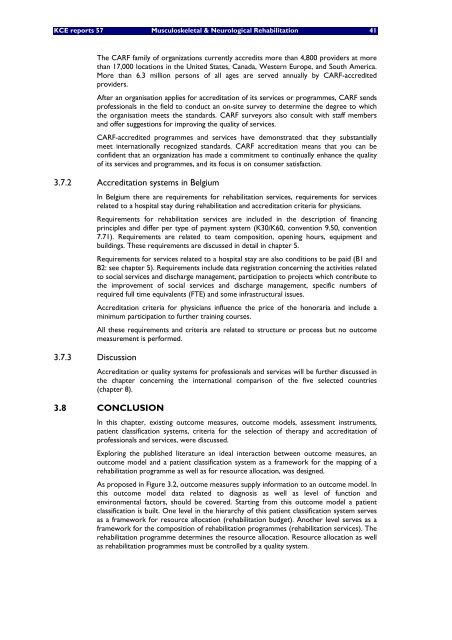The report is available in English with a French summary - KCE
The report is available in English with a French summary - KCE
The report is available in English with a French summary - KCE
You also want an ePaper? Increase the reach of your titles
YUMPU automatically turns print PDFs into web optimized ePapers that Google loves.
<strong>KCE</strong> <strong>report</strong>s 57 Musculoskeletal & Neurological Rehabilitation 41<br />
<strong>The</strong> CARF family of organizations currently accredits more than 4,800 providers at more<br />
than 17,000 locations <strong>in</strong> the United States, Canada, Western Europe, and South America.<br />
More than 6.3 million persons of all ages are served annually by CARF-accredited<br />
providers.<br />
After an organ<strong>is</strong>ation applies for accreditation of its services or programmes, CARF sends<br />
professionals <strong>in</strong> the field to conduct an on-site survey to determ<strong>in</strong>e the degree to which<br />
the organ<strong>is</strong>ation meets the standards. CARF surveyors also consult <strong>with</strong> staff members<br />
and offer suggestions for improv<strong>in</strong>g the quality of services.<br />
CARF-accredited programmes and services have demonstrated that they substantially<br />
meet <strong>in</strong>ternationally recognized standards. CARF accreditation means that you can be<br />
confident that an organization has made a commitment to cont<strong>in</strong>ually enhance the quality<br />
of its services and programmes, and its focus <strong>is</strong> on consumer sat<strong>is</strong>faction.<br />
3.7.2 Accreditation systems <strong>in</strong> Belgium<br />
In Belgium there are requirements for rehabilitation services, requirements for services<br />
related to a hospital stay dur<strong>in</strong>g rehabilitation and accreditation criteria for physicians.<br />
Requirements for rehabilitation services are <strong>in</strong>cluded <strong>in</strong> the description of f<strong>in</strong>anc<strong>in</strong>g<br />
pr<strong>in</strong>ciples and differ per type of payment system (K30/K60, convention 9.50, convention<br />
7.71). Requirements are related to team composition, open<strong>in</strong>g hours, equipment and<br />
build<strong>in</strong>gs. <strong>The</strong>se requirements are d<strong>is</strong>cussed <strong>in</strong> detail <strong>in</strong> chapter 5.<br />
Requirements for services related to a hospital stay are also conditions to be paid (B1 and<br />
B2: see chapter 5). Requirements <strong>in</strong>clude data reg<strong>is</strong>tration concern<strong>in</strong>g the activities related<br />
to social services and d<strong>is</strong>charge management, participation to projects which contribute to<br />
the improvement of social services and d<strong>is</strong>charge management, specific numbers of<br />
required full time equivalents (FTE) and some <strong>in</strong>frastructural <strong>is</strong>sues.<br />
Accreditation criteria for physicians <strong>in</strong>fluence the price of the honoraria and <strong>in</strong>clude a<br />
m<strong>in</strong>imum participation to further tra<strong>in</strong><strong>in</strong>g courses.<br />
All these requirements and criteria are related to structure or process but no outcome<br />
measurement <strong>is</strong> performed.<br />
3.7.3 D<strong>is</strong>cussion<br />
Accreditation or quality systems for professionals and services will be further d<strong>is</strong>cussed <strong>in</strong><br />
the chapter concern<strong>in</strong>g the <strong>in</strong>ternational compar<strong>is</strong>on of the five selected countries<br />
(chapter 8).<br />
3.8 CONCLUSION<br />
In th<strong>is</strong> chapter, ex<strong>is</strong>t<strong>in</strong>g outcome measures, outcome models, assessment <strong>in</strong>struments,<br />
patient classification systems, criteria for the selection of therapy and accreditation of<br />
professionals and services, were d<strong>is</strong>cussed.<br />
Explor<strong>in</strong>g the publ<strong>is</strong>hed literature an ideal <strong>in</strong>teraction between outcome measures, an<br />
outcome model and a patient classification system as a framework for the mapp<strong>in</strong>g of a<br />
rehabilitation programme as well as for resource allocation, was designed.<br />
As proposed <strong>in</strong> Figure 3.2, outcome measures supply <strong>in</strong>formation to an outcome model. In<br />
th<strong>is</strong> outcome model data related to diagnos<strong>is</strong> as well as level of function and<br />
environmental factors, should be covered. Start<strong>in</strong>g from th<strong>is</strong> outcome model a patient<br />
classification <strong>is</strong> built. One level <strong>in</strong> the hierarchy of th<strong>is</strong> patient classification system serves<br />
as a framework for resource allocation (rehabilitation budget). Another level serves as a<br />
framework for the composition of rehabilitation programmes (rehabilitation services). <strong>The</strong><br />
rehabilitation programme determ<strong>in</strong>es the resource allocation. Resource allocation as well<br />
as rehabilitation programmes must be controlled by a quality system.

















